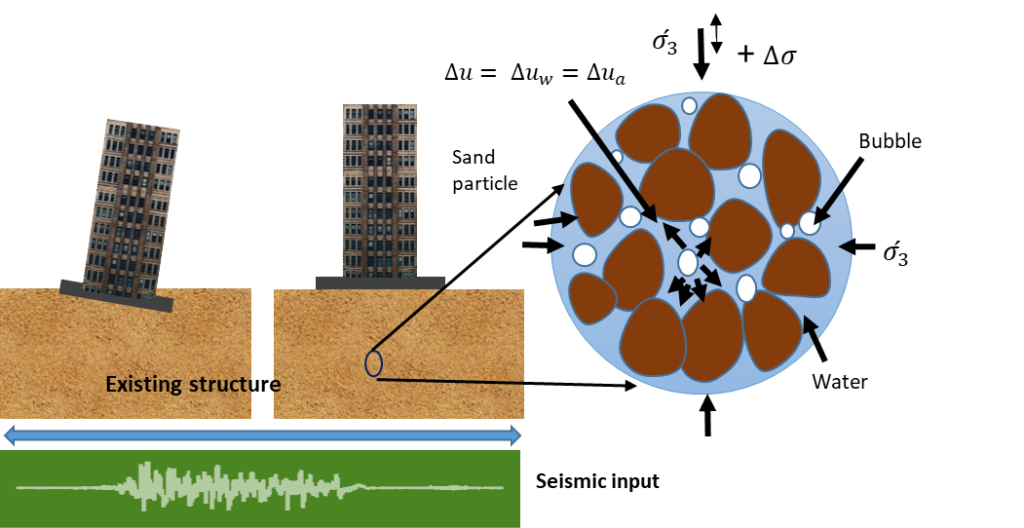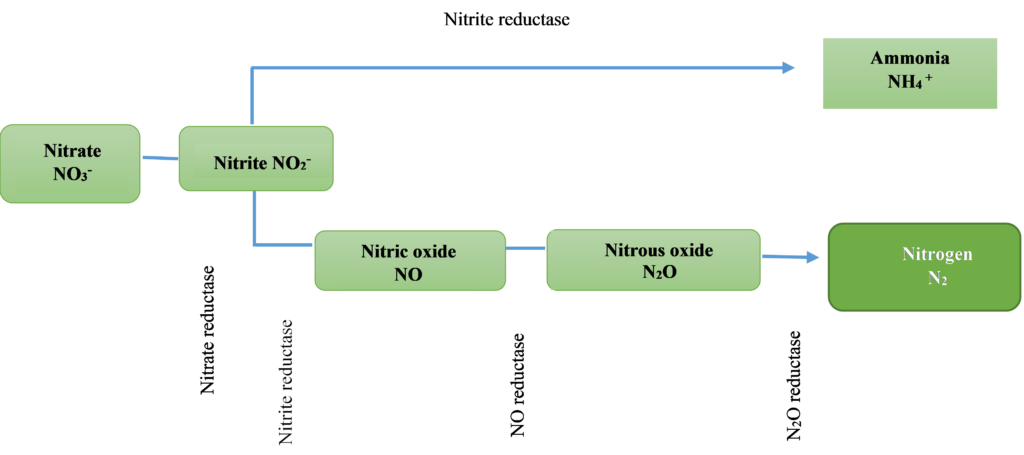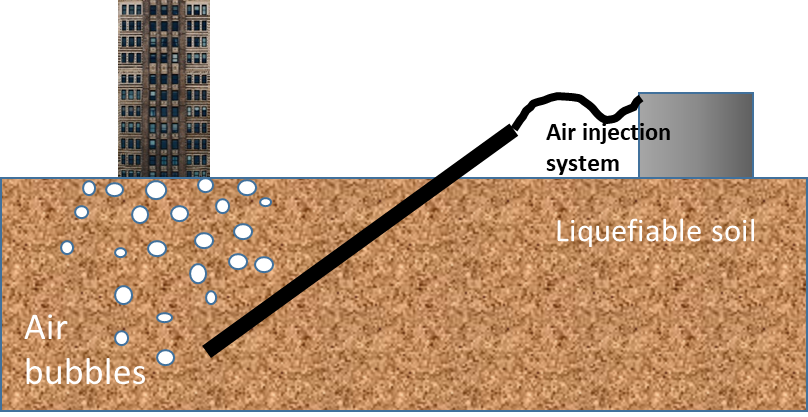Home

Research is important because it will help us to know where to find different types of information to solve engineering problems. As an engineer, we will be required to research engineering guidelines, standards, and other sources to prevent engineering failures. Geotechnical engineers help design structures that are either composed of soil or rock or are in contact with it. In essence, they engineer the interface between the natural and built environments. Research provides insight into the interaction and performance of structures with earth, such bearing failures, settlement damage, and failures due to emergent processes such as landslides and liquefaction.
Rima Das
Earthquake Geotechnical Researcher
If we knew what we were doing, it would not be called research, would it?
Albert Einstein
Latest
IGC2021 (GEO-INDIA) – NIT Trichy
The organizing committee of the conference invites the original research and field case study papers from the researchers, academicians, and practicing engineers to be presented in the Indian Geotechnical Conference-2021 (IGC 2021) during 16th – 18th December 2021, at NIT Trichy.
Read MorePrime Minister’s Research Fellows (PMRF) Scheme
The Prime Minister's Research Fellows (PMRF) Scheme has been designed for improving the quality of research in various higher educational institutions in the country.
Read MoreAbout Me
I am Civil Engineer by profession and at present pursuing PhD at NIT Trichy under PMRF fellowship under supervision of Dr. K. Muthukkumaran, Professor, Dept of Civil Engineering NIT Trichy.
I completed my middle and high school from my hometown, Agartala in Tripura. I was awarded a Bachelors in Technology (B.Tech.) degree in Civil Engineering from National Institute of Technology Agartala (NIT Agartala), an institute of national importance, in May 2017 and M.Tech in Seismic Science and Engineering from National Institute of Technology Agartala (NIT Agartala) in June 2020. Presently I am enrolled in PhD (PhD) course in Geotechnical Engineering at National Institute of Technology Trichy (NIT Trichy).
Area of Interest
- Earthquake Geotechnical Engineering
- Liquefaction analysis
- Liquefaction risk mitigation by Induced partial saturation
- Ground response analysis and seismic hazard assessment
- Seismic microzonation,
- Low cost housing
- Rammed earth Technology
Education
PhD: Ongoing
Institute: National Institute of Technology Tiruchirappalli
Specialization: Geotechnical Engineering
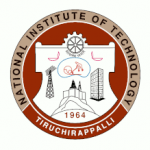
Mtech: Completed (2020)
Institute: National Institute of Technology Agartala
Specialization: Seismic Science and Engineering

B Tech.: Completed (2017)
Institute: National Institute of Technology Agartala
Specialization: Civil Engineering

Research
Current Research
Main purpose of this project is to improve earthquake liquefaction risk mitigation planning, design and execution with reference to an innovative and environmentally friendly Ground Improvement (GI) technology named Induced Partial Saturation (IPS).
By introducing a certain amount of air or gas into the voids of the soil, partial saturation can be increased and so that resistance to liquefaction susceptibility will also increase. Induced partial saturation can increase the compressibility of the pore fluid. So, during earthquake loading, the pore pressure build-up is reduced, and it leads to an increase in the soil cyclic resistance, without affecting any nearby structure. Some researchers have found that an initially saturated sand can experience relevant effect even if there is a small reduction of the degree of saturation.
The research team is very keen to developing IPS implementation because India being a highly seismic country with many areas at risk of liquefaction, and also having the goal to implement environmentally friendly technologies. This method is being a carbon free technology, it has the potential of beating more conventional mitigation techniques, that often rely on the injection of cement/lime in the soil. The development of the technology readiness level of IPS technique to show the way of important opportunities in the national and international markets of economically sustainable methodologies for the mitigation of liquefaction effect.
Mechanism of IPS
In general, the terms “unsaturated,” “partially saturated,” and “fully saturated” soil can be used to describe different soil conditions. Continuous air phases inside the soil aggregates will ultimately disappear, and the matric suction would decrease, leading to a phase transition from unsaturation to partial saturation. Despite their ability to change the compressibility of pore water, these air bubbles, which are largely present in pore water, will not interact significantly with soil aggregates. The mechanism behind IPS is that the presence of air bubbles lowers the bulk modulus of the pore fluid, enabling the soil to conserve energy by decreasing its volume while preventing the development of further pore pressure due to cyclic loading. Because of the low volumetric stiffness of gases, the fluid bulk modulus is extremely sensitive to the presence of gas. Even tiny amounts of gas greatly reduce the fluid bulk modulus, which causes the production of excess pore water.
Advantages of this technique:
- Environmentally friendly
- Economical
- Applicable without affecting any nearby structure.
- Applicable under existing structures
Planned work flow:
1st method of IPS – Microbial Induced partial saturation (MIPS)
- In the biological process of denitrification, nitrate (NO3) is gradually converted to nitrogen gas (N2). A wide variety of bacteria, including Pseudomonas, Paracoccus, Flavobacterium, Alcaligenes, and Bacillus spp., participate in heterotrophic denitrification, which employs an organic carbon electron donor like methanol, ethanol, or acetic acid (Mieczyslaw Blaszczyk 1993; Park and Yoo 2009).
- Nitrogen gas (N2) is neither flammable nor a greenhouse gas, which is one of its many advantages that are pertinent to this investigation. The most significant characteristic is its extremely low solubility, which is 0.014 l of gas per liter of water at 250°C and atmospheric pressure (He and Chu, 2014).
- Knowing the principles and limiting variables of the microbial denitrification process, Pseudomonas stutzeri was chosen to perform the soil desaturation experiment. Dry powdered Pseudomonas stutzeri (MTCC 863) was purchased and grown on a petri dish stabilized with nutrient agar.
- Preliminary Microbial batch test on sand sample to confirm nitrate reductase, to determine optimum nitrate content, pH and different temperature effect.
- Modification was done for this application method to the typical triaxial configuration
- Series of Cyclic traxial test were performed with different relative density, confining pressure, and cyclic stress ratio (CSR) which has computed according to Earthquake magnitude of moderate to major.
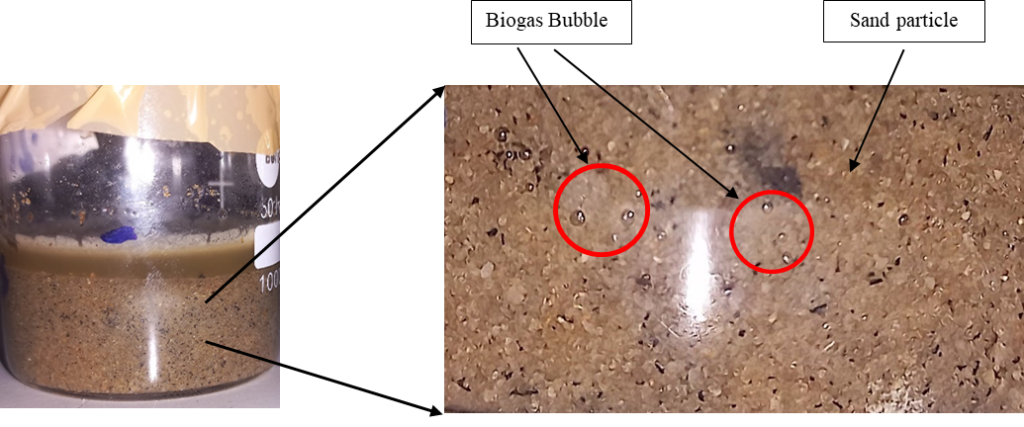
2nd IPS method – Direct air injection
- The triaxial facility was altered to include an air compressor line that was linked to the base of the sample in order to facilitate and precisely maintain the air injection pressure.
- Series of cyclic triaxial test were performed with different relative density, confining pressure, and cyclic stress ratio which has computed according to Earthquake magnitude of moderate to major.
- Development of air injection setup and test series were performed with different set of air injection pressure, duration and different overburden for developing relation between air injection pressure and degree of saturation ,duration without creating crack in sample.
- The factor of safety (Fliq) against the liquefaction of saturated and desaturated sand at various degrees of saturation is determined against several earthquakes ranging from strong to major magnitude by converting lab (Cyclic resistance ratio) CRR to field CRR.
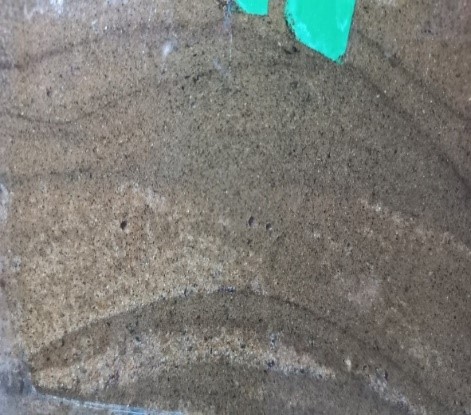 Visible desaturated zone after air injection process in fully saturated sand samples.
Visible desaturated zone after air injection process in fully saturated sand samples.
In micribial induced partial saturation(MIPS) study , partial saturation generated by denitrifying bacteria metabolism has been
evaluated, as well as the liquefaction behaviour of the treated sample. The desaturation test
proved that the microbial denitrification process may create nitrogen (N2) gas in sand, resulting
in the sand desaturation. By changing the nitrate content of the soil, a saturation level of
less than 80% can be reached. The cyclic triaxial test reveals that reducing the saturation level
of sand from 100 % to 90% can greatly reduce its liquefaction potential. Saturated sands lose
their stiffness much more rapidly than partially saturated sands when subjected to cyclic loading,
as evidenced by the less number of cycles necessary to produce early liquefaction in the
saturated samples. After inducing partial saturation with the MIPS approach, the soil’s resistance
to liquefaction increases rapidly. This suggests that induce partial saturation of sand by
this technique can be a highly effective countermeasure against liquefaction.
Publication
Journal Publication
- Raj, S., Mohammad, S., Das, R. and Saha, S. (2017) “Coconut fibre-reinforced cement-stabilized rammed earth blocks” World Journal of Engineering, Vol. 14 Issue: 3, pp.208-216. DOI: 10.1108/WJE-10-2016-0101. Click here for details
Conference Proceedings
- Das, R., Muthukkumaran K. (2023) “Mitigation of liquefaction through induced partial saturation by bio – gas bubbles”, 17th Asian Regional Conference 2023, Kazakhstan. Smart Geotechnics for Smart Societies Zhussupbekov, Sarsembayeva & Kaliakin (Eds)© 2023 The Author(s), ISBN 978-1-003-29912-7 DOI: 10.1201/9781003299127-251
- Das, R., Sreelakshmi N., Muthukkumaran K. (2022) “Laboratory study on soil desaturation by Microbial Methods”, IGC Kochi 2022.
- Muthukkumaran, k., Pradhan, Y., Das, R. (2021) “Seismic performance evaluation of E-waste Georeinforced embankment and pavement ” IGC Trichy 2021
- Das, R.,Saha, R.,Debnath R., (2020) “Assessment of Local Seismic Hazard of Agartala based on Nonlinear Site Response Analysis”, IGC2020 Indian Geotechnical Conference December ,Andhra University, Visakhapatnam. Click here for details
- Tripura, D.D., Raj, S., Mohammad, S. and Das, R. (2018) “Suitability of Recycled Aggregate as a Replacement for Natural Aggregate in construction”, DSCS 2018, ACI Special Publication, Moscow, Russia. Click here for details
Technical Report
- Raj, S., Mohammad, S., Das, R., Saha, S. and Tripura, D.D. (2016) ” Low cost housing models for urban and rural areas using rammed earth technique.” ResearchGate, Technical Report (1). DOI: 10.13140/RG.2.2.22676.50567 Click here for details
Supervisor

Dr. K. MUTHUKKUMARAN
Professor
Department Of Civil Engineering
National Institute of Technology
Tiruchirappalli – 620015
Tamil Nadu, India
Phone : +91 431 2503168
Mobile: +91 9443651836
Fax : +91 431 2500133
e-Mail: [email protected] / [email protected]
Link to Profile
Institute Website Google Scholar Research Gate
Scopus Orcid
Dr. K. Muthukkumaran has obtained his BE (Civil & Structural Engg.) from Annamalai University in 1998, Masters from GEC, Anna University, Chennai in 2000 and Ph.D. from IIT Madras in 2005. He worked as a Senior Geotechnical Engineer at OEO, Saudi Aramco, Saudi Arabia prior to NIT Trichy from 2005 to 2006. In 2006, he joint as lecturer in NIT Trichy and presently he is Professor at NIT Trichy. He has published more than 100 papers in international and national journals and conferences. He has guided 8(guiding 8) Ph.D., 5 MS and 28 Postgraduate theses. He received DST Young Scientist Award and IGS- Smt. Indra Joshi Biennial award by IGS Delhi. Ministry of Housing and Urban Poverty Alleviation has appointed him as External Expert Reviewer of HUDCO (Tamil Nadu) Projects. He has completed 5 R & D (including ISRO – Chandrayaan- 2 Mission project) and 42 major consultancy projects. He has delivered 50 invited/guest lecturers and organized 7 workshop/short term courses in Geotechnical Engineering. He is the Founder Chairman of Indian Geotechnical Society (IGS-Trichy) Trichy Chapter. He is the Chairman of 6IYGEC, to be held in March 2017 at NIT Trichy. He is a member of ISSMGE –TC-102 and IGS-TC-04.He is the Chairman of IGC2021 NIT Trichy. He has been elected as member of IGS-Delhi Executive Committee for 2017-18. His area of research is in geotechnical engineering, which includes pile foundation, soil-structure interaction, marine geotechnics & foundations, field instrumentation, geotechnical physical modeling, ground improvement and forensic geotechnical engineering.
Office address
C1 Lab
Department of Civil Engineering,
National Institute of Technology,
Tiruchirappalli – 620015
Tamil Nadu, India
Home address
Room No.:B Block, 38,
Opal Hostel,
National Institute of Technology,
Tiruchirappalli – 620015
Tamil Nadu, India
